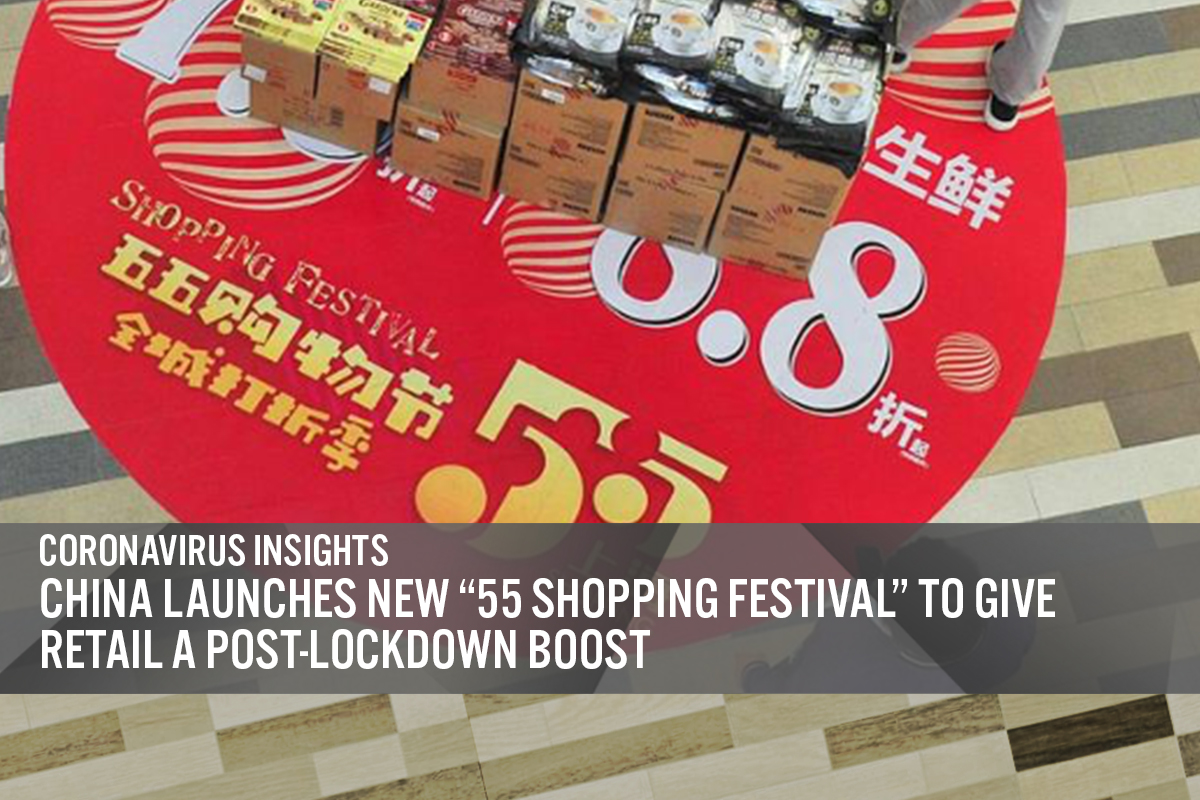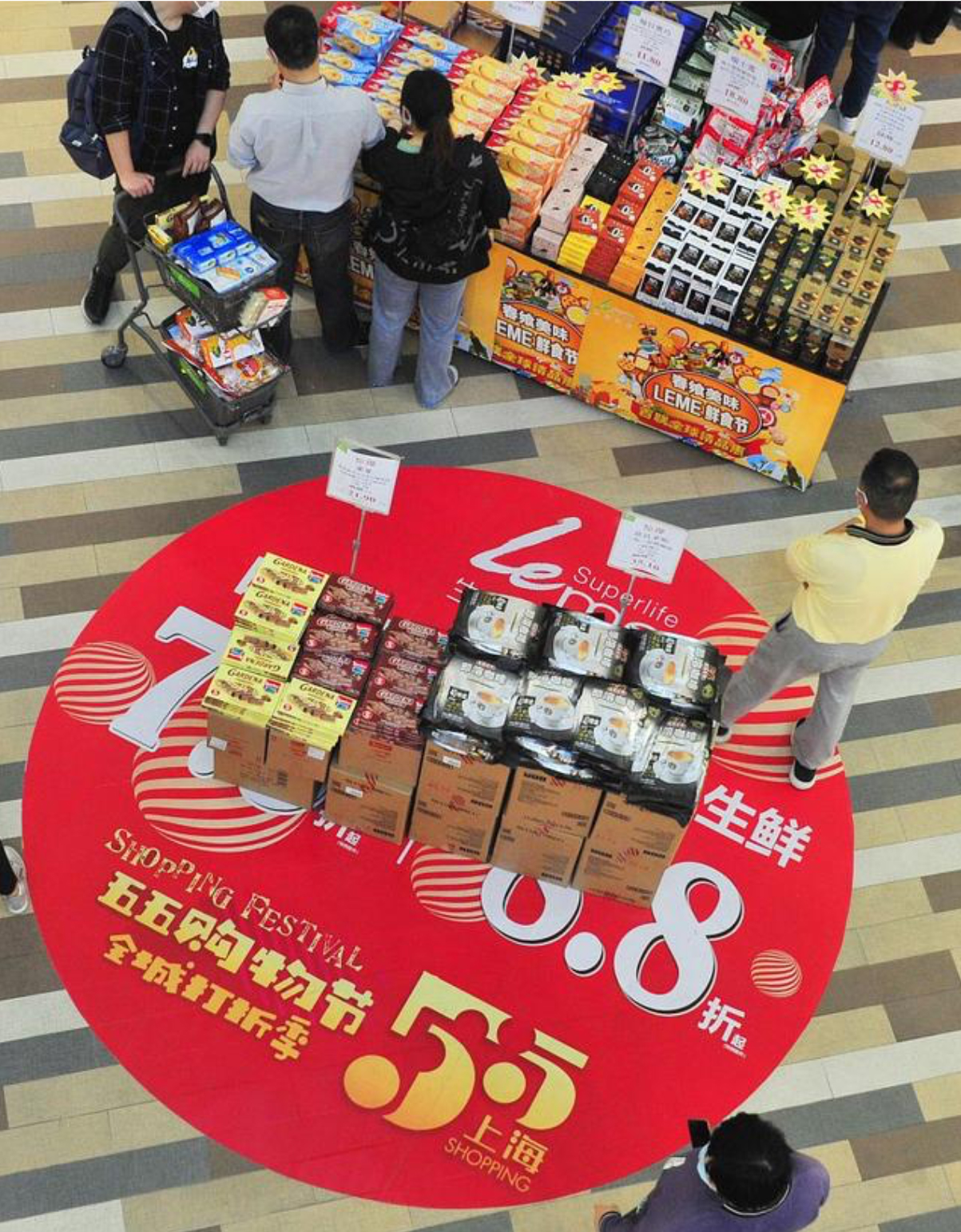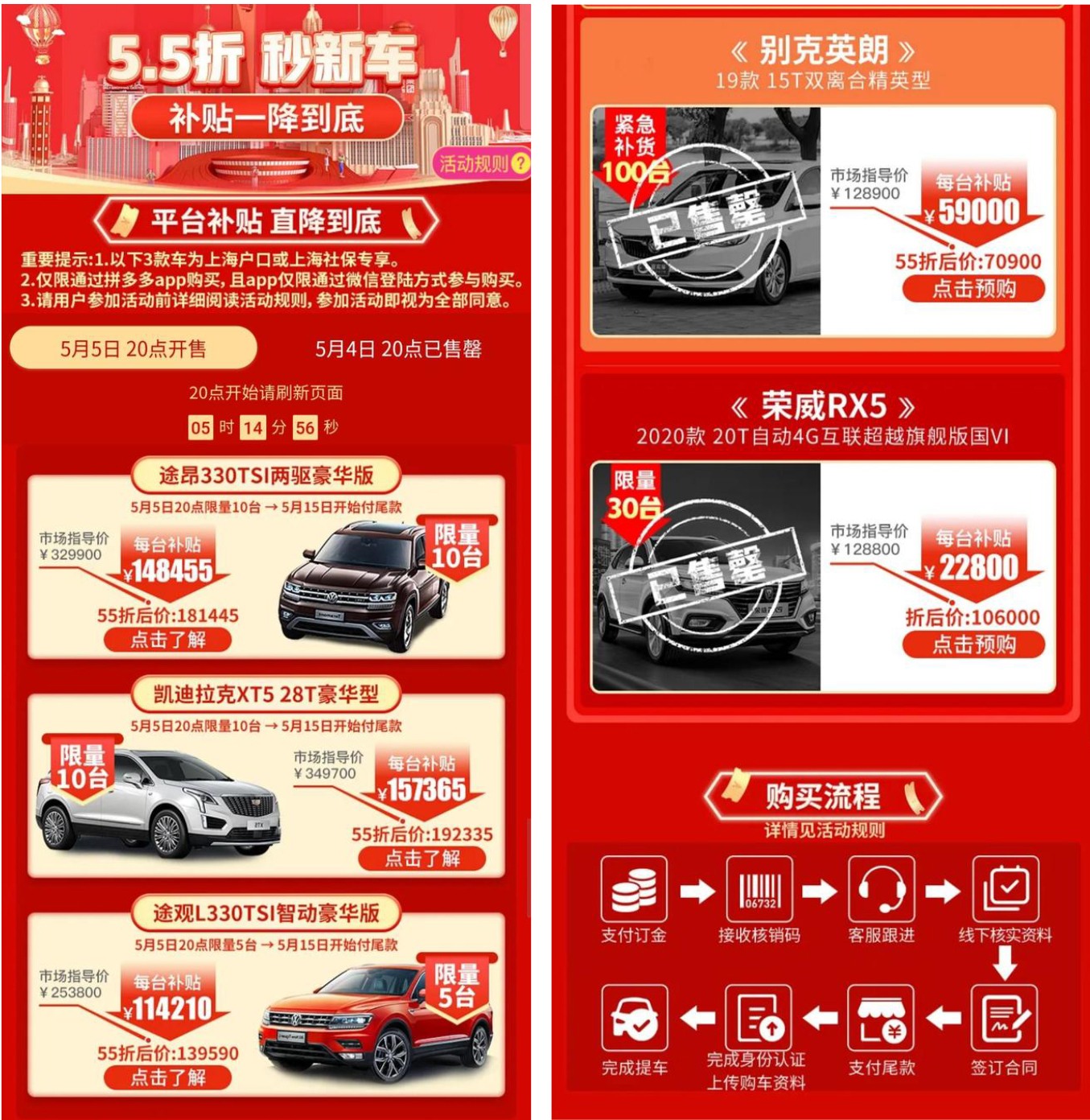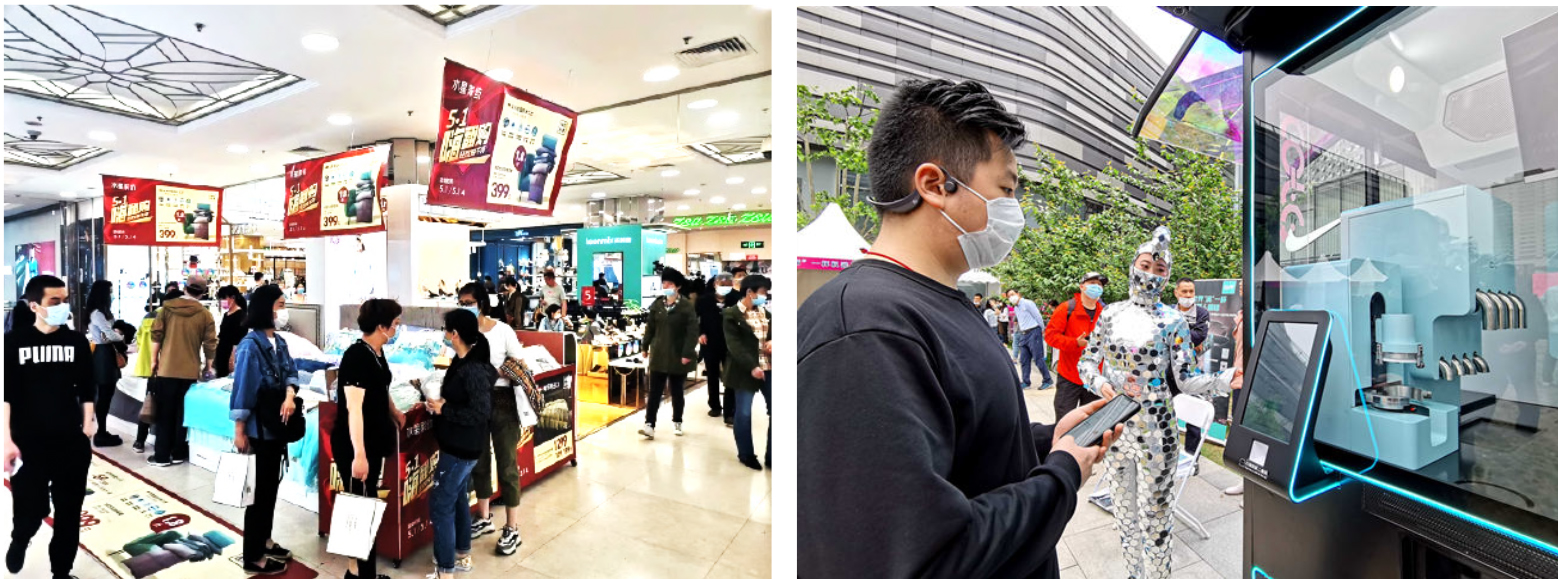
DIpil Das
Following strict lockdowns in China due to the coronavirus pandemic, retailers have begun to resume normal operations as the nation emerges from the crisis. To stimulate the economy and encourage consumers to release pent-up demand post Covid-19, the city of Shanghai co-launched a new, large-scale shopping holiday with the commerce industry at the start of May 2020. The 55 Shopping Festival will run for two months, comprising a series of shopping events, activities and promotions.
In this report, we look at how the 55 Shopping Festival is boosting the post-lockdown economy in China.
A Season of Shopping with Scale and Impact
Shopping festivals in China are typically the creations of e-commerce platforms, such as Alibaba’s Singles’ Day (11.11) or JD.com’s Midyear 6.18 Festival. However, the Double Five Shopping Festival is instead being driven by the joint efforts of the Shanghai Municipal People’s Government and commerce, including a large number of retailers, both online and offline.
As the name suggests, the 55 Shopping Festival officially began on May 5, following a launch ceremony the day before. The ceremony was attended by officials of the Shanghai government, such as Shanghai Party Secretary Li Qiang and Deputy Party Secretary and Acting Mayor Gong Zheng, together with over 20 executives from multinational companies and domestic firms—including Bailian Group, China UnionPay, Ctrip, L’Oréal, Meituan Dianping, Suning and Tesla.
The government-driven 55 Shopping Festival is intended to stimulate growth in discretionary consumer spending post lockdown. Indicating the opportunities that companies believe they can leverage from the festival, Fabrice Megarbane, President and CEO of L’Oréal China, said at the launch ceremony that the personal care company hopes to “expedite the introduction of new brands, products, business formats and technologies in the city and to launch Asian and even world premier products for more innovative offerings here,” according to the Shanghai Municipal People’s Government.
Although the festival officially had its first full day on May 5, promotions for Double Five were initiated as early as May 1 (as we discuss later in this report). The festival included Mother’s Day on May 10, and as it is set to run for two months, it will therefore encompass International Children's Day on June 1 and the Dragon Boat Festival on June 7. The scale of the shopping holiday is evident through the 700-plus planned promotional activities that are set to be held in May and June in the city of Shanghai.
In terms of the festival’s potential to generate spending, the Shanghai Municipal Commission of Commerce reported that Double Five saw combined sales through online and offline channels surpass ¥100 million ($14.1 million) in just six minutes after the event began at 8:00 p.m. on May 4, according to data from mobile payment platforms Alipay, China UnionPay and WeChat Pay. Furthermore, sales exceeded ¥10 billion ($1.4 billion) by 2:12 p.m. on May 5—just over 18 hours after the launch event—and ¥15.7 billion (2.2 billion) within 24 hours. This is a huge figure for just the first day of the new event, considering that total sales in Shanghai on Singles’ Day 2019, a long-established shopping holiday, amounted to ¥17.3 billion ($2.4 billion).
E-commerce platforms are actively participating in the 55 Shopping Festival. For example, during May 5–7, Alibaba’s Tmall offered ¥30 (around $4.20) discounts for every ¥300 ($42.30) spent (the same deal it provides for 6.18 and 11.11) across brands and stores with the red “55 Shanghai Shopping Festival” tag. According to Alibaba, the turnover of Shanghai merchants on Tmall saw nearly 200% year-over-year growth on May 5. A number of local brands performed notably well on the platform, achieving high sales in a short time frame:
- Within 16 minutes, Mercury Home Textiles sold more than what it did for the whole day of May 5 last year.
- Five minutes after midnight on May 5, sales on the Adidas official Tmall flagship store exceeded the total from May 5 and 6 in 2019.
- Sales of gold by Shanghai’s well-established Old Temple jewelry brand increased by more than 4,000% year over year.
 Double Five sales exceeded ¥10 billion ($14.1 million) by 2:12 p.m. on May 5, from 8:00 p.m. on May 4
Double Five sales exceeded ¥10 billion ($14.1 million) by 2:12 p.m. on May 5, from 8:00 p.m. on May 4 Source: weibo.com [/caption] [caption id="attachment_110016" align="aligncenter" width="700"]
 Large signs indicate promotions for the 55 Shopping Festival in brick-and-mortar stores in Shanghai
Large signs indicate promotions for the 55 Shopping Festival in brick-and-mortar stores in Shanghai Source: baidu.com [/caption] An Omnichannel Approach to Shopping and Promotions The 55 Shopping Festival provides an omnichannel shopping experience for consumers, with participation from e-commerce platforms, brand enterprises and malls/outlets. Promotional coupons and vouchers are being issued on mobile e-commerce platforms and at shopping mall terminals, driving consumers that shop online to return to malls to access deals. Discounts offered by e-commerce platforms and offline retailers—through coupons, vouchers and direct discounts—during the first wave of Double Five amounted to ¥15 billion ($2.1 billion), including ¥2.5 billion ($352 million) from Pinduoduo, ¥2 billion ($282 million) each from Alibaba and Suning, and ¥1.2 billion ($169 million) each from Bailian Group and Meituan. In addition to opening a dedicated online zone for the 55 Shopping Festival on its platform, Pinduoduo further encouraged consumers to visit brick-and-mortar stores in Shanghai during the 55 Shopping Festival by giving them the chance to receive discounted vouchers to spend offline when they purchased through the Pinduoduo app in advance of the shopping holiday—for example, spending ¥55 ($7.75) entitled the shopper to a department-store voucher worth ¥100 ($14.10). According to Pinduoduo, it issued vouchers and coupons worth more than ¥2.5 billion ($352 million) from midnight on May 1 to 4:00 p.m. on May 5. We outline some of the platform’s promotions below. On May 1, Pinduoduo launched the first batch of 10,000 vouchers for Shanghai New World City (a famous shopping center), which were sold out in less than half an hour. The vouchers were sold at a discounted price to their face value—for instance, a ¥400 (around $56.40) voucher could be bought for ¥300 ($42.30) on Pinduoduo, the equivalent of 25% discounts in store. Shoppers who purchased the vouchers that day queued up at a voucher exchange office in Shanghai New World City to redeem it at the shopping center. Vouchers distributed by Pinduoduo also cover other Shanghai commercial centers, such as No. 1 Yaohan, No. 1 Department Store, Bailian Central Shopping Plaza and Shanghai Century Lianhua, as well as Shanghai Hualian Supermarket and other supermarket channels. On May 4, Pinduoduo launched a promotion through which shoppers could purchase cars for 55% of the original price (i.e., at a 45% discount). The campaign drove large consumption momentum: the Cadillac XT5 sold out in seconds; Chevrolet had to replenish its inventory four times; and the Buick Hideo sold out five times. [caption id="attachment_110017" align="aligncenter" width="700"]
 Pinduoduo sold cars with 45% discounts on May 4
Pinduoduo sold cars with 45% discounts on May 4 Source: Pinduoduo app [/caption] Many department stores have also livestreamed their own promotions during Double Five, to attract online consumers to visit their brick-and-mortar stores—including the Shanghai No. 1 Department Store. Of course, they have heavily promoted discounts and 55 Shopping Festival-themed deals in store as well. [caption id="attachment_110018" align="aligncenter" width="700"]
 Shopping malls in Shanghai during the 55 Shopping Festival
Shopping malls in Shanghai during the 55 Shopping Festival Source: weibo.com [/caption] Double Five Promotes “Shopping and Tourism” As the 55 Shopping Festival season will encompass a number of traditional festivals and holidays, “shopping and tourism” has become a new model to boost the economic recovery of the city of Shanghai. In advance of May 5, the tourism sector saw promotional activities for Double Five being launched to coincide with the Labor Day holiday (on May 1). According to Ctrip.com, a major e-booking and provider of travel services in China, bookings for Shanghai travel—including by air, train and bus—from April 30 to May 5 were tagged as part of the 55 Shopping Festival and travelers were given discounts accordingly. Ctrip provided discounts and vouchers worth ¥1 billion ($14.1 million) for Double Five and has launched more than 500 Shanghai tourism and vacation products, as well as new types of Shanghai tours. During the 55 Shopping Festival, shopping centers have also launched “shopping and tourism” promotions. For example, the Zhongshan Park Cloud 9 shopping center is offering a voucher for Tai Lake travel for every ¥500 (around $70.50) spent. The 55 Shopping Festival season is driving purchases of future holidays in May and June at discounted prices, helping hotels and service providers to secure bookings in advance. Movie theaters, theaters, music festivals, hotels and travel providers are offering large discounts for customers that purchase tickets they can use for the next two months, in order to encourage consumers to release demand for experiential entertainment and traveling following the coronavirus crisis. [caption id="attachment_110019" align="aligncenter" width="700"]
 Shanghai Century Park during the 55 Shopping Festival
Shanghai Century Park during the 55 Shopping Festival Source: Coresight Research [/caption] Looking Ahead With Double Five having generated such high sales within its first 24 hours, the new festival has proven to be a successful stimulant for Chinese consumers both online and offline, at least in the short term. Additional boosts will be generated by the traditional holidays that Double Five encompasses, particularly as the festival has an omnichannel presence. For example, according to data released by the Shanghai Business Development Research Center, sales for Mother’s Day (the period of May 6–10, 2020) in offline retail increased by 2.6% year over year—with Shanghai’s jewelry brands seeing sales volumes increase by 22.4% compared to 2019. As the Shanghai Municipal People’s Government plans to maintain this momentum over the course of the two-month holiday, we expect that the 55 Shopping Festival will build on the instant boost it has provided to Shanghai’s economy, supporting the city’s recovery from the impacts of the coronavirus pandemic. The influence of the tourism sector will contribute greatly to this recovery. Outbound traveling remains restricted due to Covid-19, so consumers may switch their international travel plans to domestic trips—as we have seen in the US—driving custom for local brands, retailers and tourism companies. If promotions continue throughout Double Five, the city of Shanghai could see a gradual recovery and sustained growth in retail sales and tourism over the second quarter of 2020.